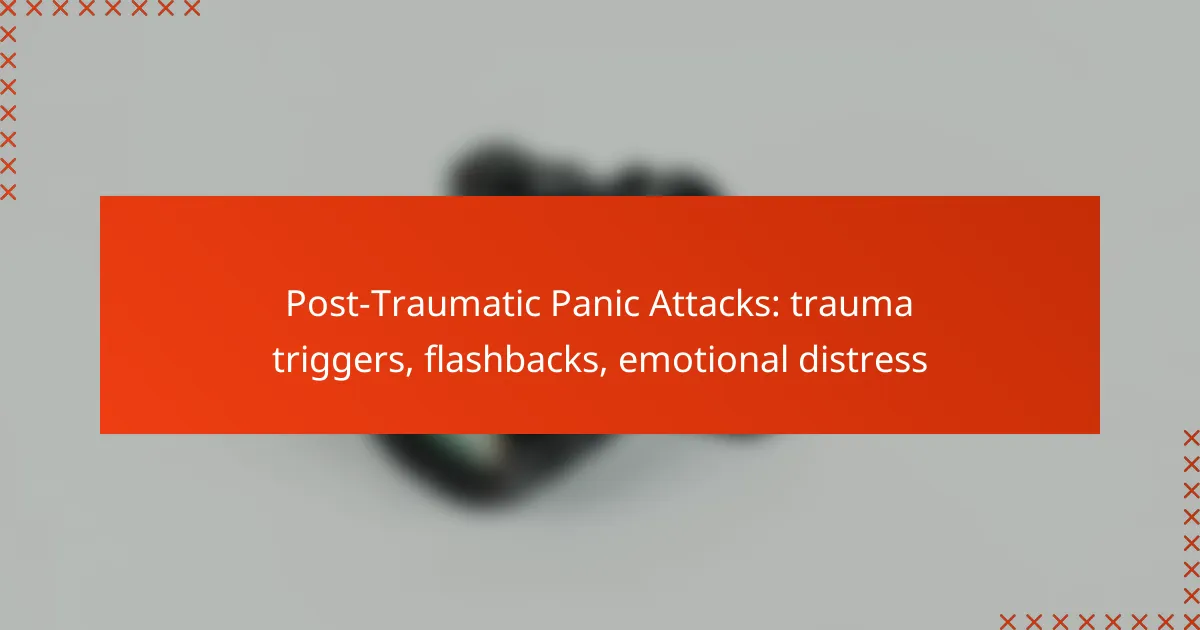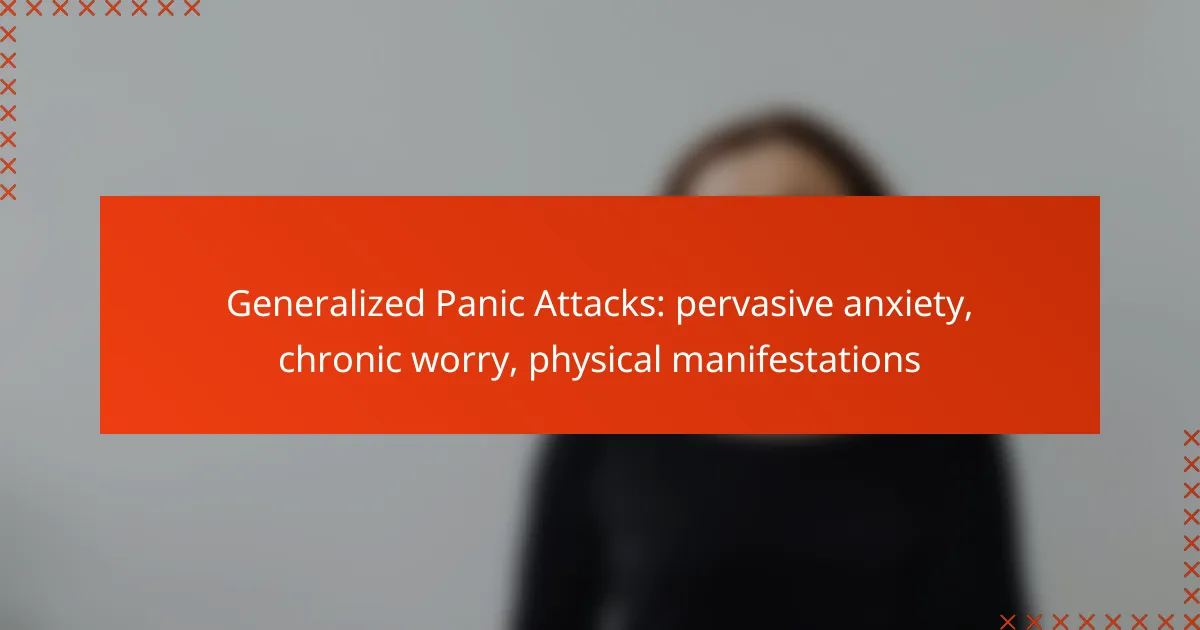Post-traumatic panic attacks are intense episodes of fear and anxiety that can occur after experiencing a traumatic event. These attacks are often triggered by specific stimuli that evoke flashbacks or emotional distress, making it essential to identify and understand these triggers for effective management. A combination of therapeutic approaches, medications, and support systems can help individuals cope with the symptoms and improve their emotional well-being.

What are effective treatments for post-traumatic panic attacks?
Effective treatments for post-traumatic panic attacks include a combination of therapeutic approaches, medications, and support systems. These methods aim to reduce symptoms, manage triggers, and improve overall emotional well-being.
Cognitive Behavioral Therapy (CBT)
Cognitive Behavioral Therapy (CBT) is a structured, time-limited approach that helps individuals identify and change negative thought patterns related to their trauma. By focusing on the connection between thoughts, feelings, and behaviors, CBT equips patients with coping strategies to manage panic attacks more effectively.
Sessions typically involve exposure to feared situations in a controlled manner, allowing individuals to gradually face their triggers. This method can lead to significant reductions in anxiety and panic symptoms over time.
Exposure Therapy
Exposure Therapy is a specific type of CBT that focuses on helping individuals confront their trauma-related fears in a safe environment. This process involves gradual exposure to the source of anxiety, which can help desensitize the individual to their triggers.
Therapists often use techniques such as virtual reality or guided imagery to simulate traumatic experiences, allowing patients to process their emotions and reactions without real-world consequences. Consistent practice can lead to a decrease in panic attacks and improved emotional resilience.
Medication options
Medication can be an effective component of treatment for post-traumatic panic attacks, particularly when symptoms are severe. Common options include selective serotonin reuptake inhibitors (SSRIs) and benzodiazepines, which can help manage anxiety and panic symptoms.
It’s essential to consult with a healthcare professional to determine the most appropriate medication and dosage, as individual responses can vary. Regular follow-ups are crucial to monitor effectiveness and adjust treatment as needed.
Mindfulness techniques
Mindfulness techniques involve practices that promote present-moment awareness and acceptance, which can be beneficial for individuals experiencing panic attacks. Techniques such as deep breathing, meditation, and yoga can help reduce anxiety levels and improve emotional regulation.
Incorporating mindfulness into daily routines can enhance overall well-being and provide individuals with tools to manage panic symptoms when they arise. Simple practices, like focusing on breath or engaging in body scans, can be done anywhere and at any time.
Support groups
Support groups offer a communal space for individuals dealing with post-traumatic panic attacks to share experiences and coping strategies. These groups can provide emotional support and reduce feelings of isolation, fostering a sense of belonging among participants.
Joining a support group can also encourage accountability and motivation in the recovery process. Many organizations offer both in-person and online options, making it easier for individuals to find a group that fits their needs and schedules.
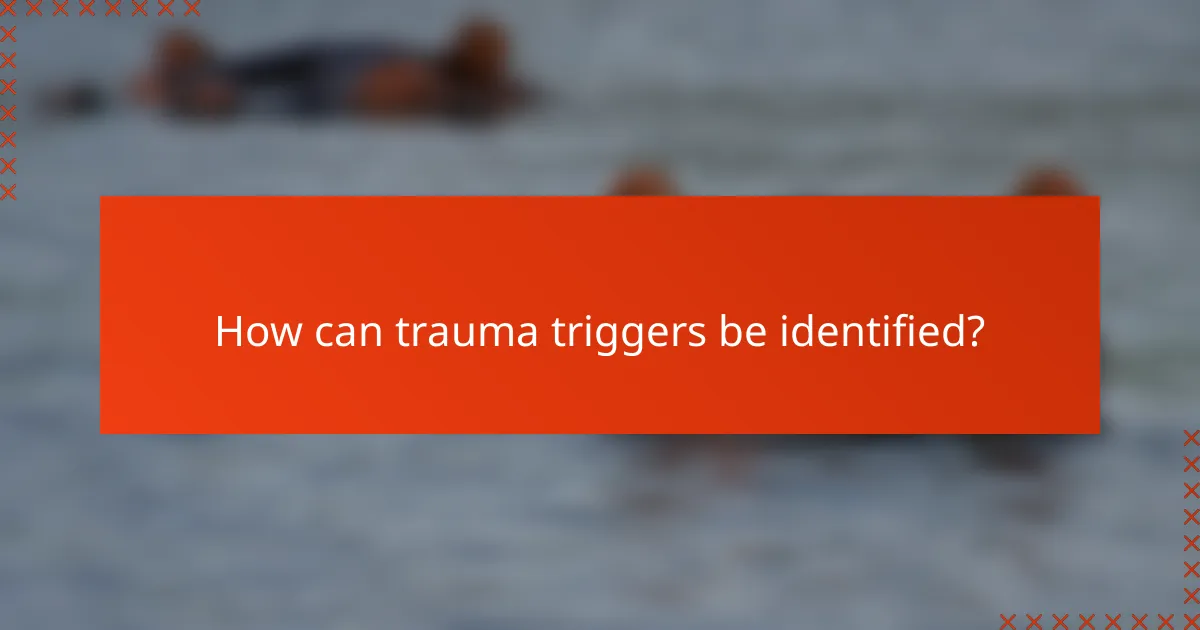
How can trauma triggers be identified?
Trauma triggers can be identified by recognizing specific stimuli that provoke intense emotional responses or flashbacks related to past traumatic experiences. Understanding these triggers is crucial for managing post-traumatic panic attacks effectively.
Common trauma triggers
Common trauma triggers often include sensory experiences such as sounds, smells, or visual cues that remind individuals of their trauma. For instance, a loud noise might evoke memories of a violent event, while a particular scent could remind someone of a distressing situation.
Other triggers may involve certain places, people, or situations that are reminiscent of the traumatic event. For example, returning to a location where a trauma occurred can elicit strong emotional reactions.
Personalized trigger assessment
Personalized trigger assessment involves evaluating individual experiences to identify specific triggers unique to each person. This can be done through self-reflection, journaling, or discussions with trusted friends or family members.
Keeping a trigger diary can be particularly helpful. Recording moments of emotional distress alongside the context can reveal patterns and help pinpoint specific triggers over time.
Role of therapy in identification
Therapy plays a vital role in identifying trauma triggers by providing a safe space to explore past experiences and their emotional impacts. A trained therapist can guide individuals through the process of recognizing and understanding their triggers.
Therapeutic techniques, such as cognitive-behavioral therapy (CBT) or exposure therapy, can help individuals confront and manage their triggers effectively. These methods promote coping strategies that reduce the intensity of emotional responses when faced with triggers.
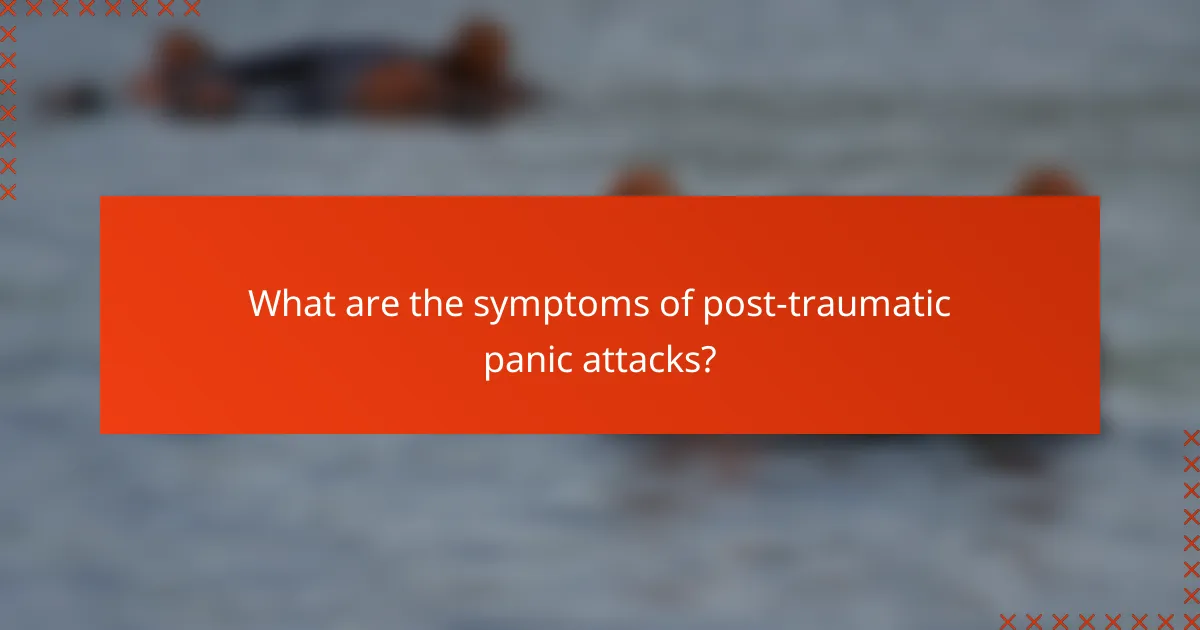
What are the symptoms of post-traumatic panic attacks?
Post-traumatic panic attacks can manifest through a range of symptoms that affect individuals both physically and emotionally. These symptoms often arise after experiencing a traumatic event and can include intense feelings of fear, anxiety, and distress.
Physical symptoms
Physical symptoms of post-traumatic panic attacks can include rapid heartbeat, shortness of breath, and sweating. Individuals may also experience trembling, dizziness, or a feeling of choking. These symptoms can be alarming and often mimic those of a heart attack, which can further heighten anxiety.
Other common physical reactions may involve gastrointestinal distress, such as nausea or stomach cramps. It is crucial to recognize these symptoms as part of a panic response rather than a physical illness to avoid unnecessary medical interventions.
Emotional symptoms
Emotional symptoms often include overwhelming feelings of fear, helplessness, or horror. Individuals may experience intense anxiety that can lead to avoidance behaviors, where they steer clear of places or situations that remind them of the trauma. This can significantly impact daily functioning and relationships.
Additionally, feelings of guilt or shame may arise, particularly if the individual believes they could have prevented the traumatic event. Recognizing these emotional responses is vital for seeking appropriate support and treatment.
Cognitive symptoms
Cognitive symptoms can manifest as intrusive thoughts or flashbacks related to the traumatic experience. Individuals may find themselves reliving the event, which can trigger panic attacks even in safe environments. This can lead to a cycle of fear and anxiety that is difficult to break.
Difficulty concentrating or making decisions is another common cognitive symptom. Individuals may feel detached from reality or experience a sense of unreality, which can exacerbate feelings of panic. Understanding these cognitive patterns can help in developing coping strategies and therapeutic interventions.
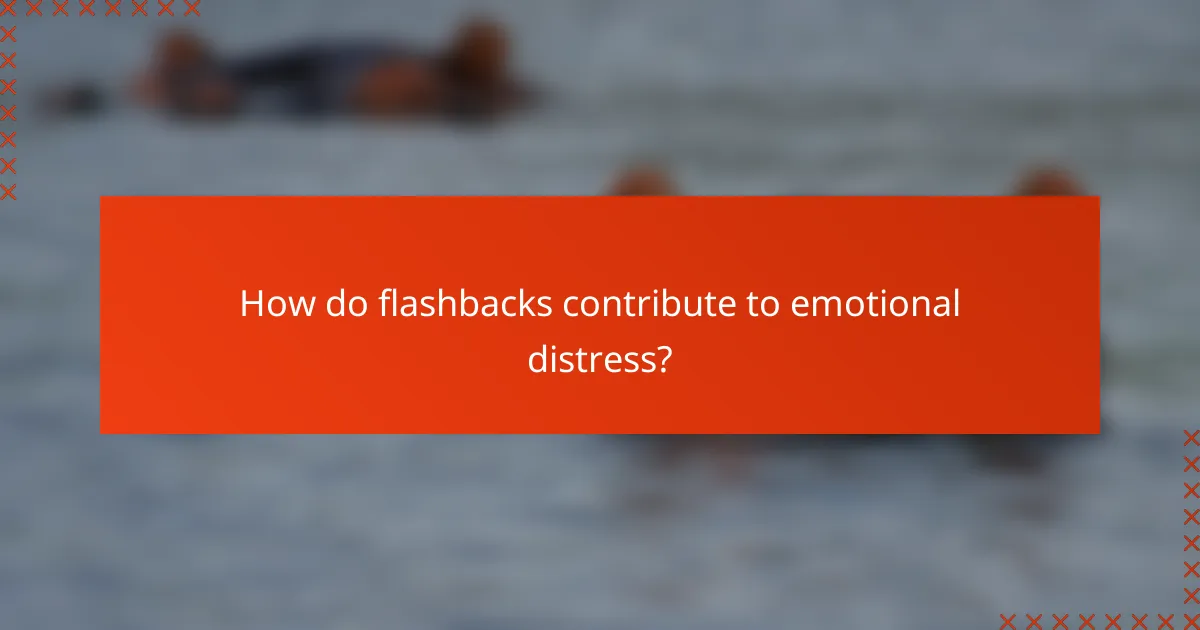
How do flashbacks contribute to emotional distress?
Flashbacks can significantly heighten emotional distress by forcing individuals to relive traumatic experiences, often leading to intense feelings of fear, anxiety, and helplessness. These involuntary memories disrupt daily functioning and can trigger panic attacks, making it difficult for individuals to cope with their emotions.
Mechanism of flashbacks
Flashbacks occur when the brain retrieves memories of traumatic events, often triggered by specific cues in the environment, such as sounds, smells, or visual stimuli. During a flashback, individuals may experience vivid recollections that feel as real as the original event, causing them to react as if they are in immediate danger.
This mechanism is linked to the brain’s fight-or-flight response, where the amygdala, responsible for processing emotions, becomes highly active. This heightened state can lead to overwhelming feelings of panic and distress, making it challenging to regain a sense of safety.
Impact on daily life
The impact of flashbacks on daily life can be profound, as they can interfere with work, relationships, and overall well-being. Individuals may avoid places or situations that remind them of the trauma, leading to social isolation and decreased quality of life.
Common symptoms during flashbacks include rapid heartbeat, sweating, and difficulty concentrating. These reactions can hinder daily activities, making it essential for individuals to develop coping strategies to manage their responses effectively.
Connection to PTSD
Flashbacks are a hallmark symptom of Post-Traumatic Stress Disorder (PTSD), which can develop after experiencing or witnessing a traumatic event. In PTSD, flashbacks are not just memories; they are intrusive experiences that can occur unexpectedly, causing significant emotional turmoil.
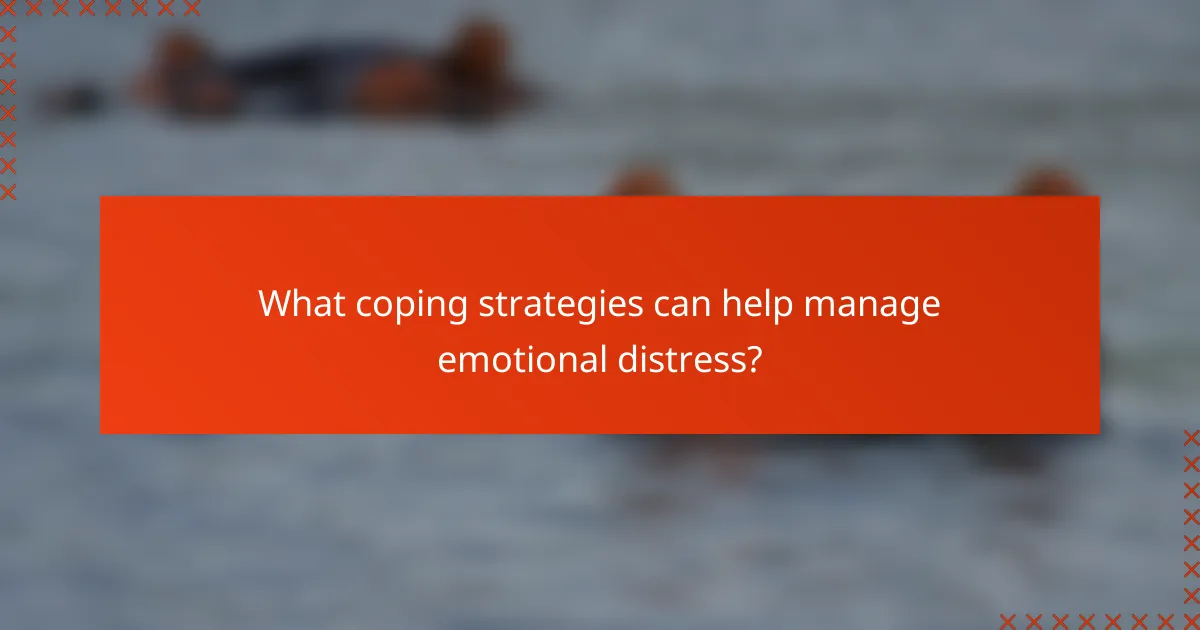
What coping strategies can help manage emotional distress?
Effective coping strategies for managing emotional distress include grounding techniques, breathing exercises, and journaling. These methods can help individuals regain control and reduce the intensity of panic attacks and flashbacks associated with trauma.
Grounding techniques
Grounding techniques help individuals reconnect with the present moment, reducing feelings of anxiety and panic. Common methods include focusing on physical sensations, such as feeling the texture of an object or noticing the temperature of the air. This practice can distract from distressing thoughts and feelings.
One effective grounding exercise is the “5-4-3-2-1” technique, where you identify five things you can see, four things you can touch, three things you can hear, two things you can smell, and one thing you can taste. This structured approach can help anchor you in reality.
Breathing exercises
Breathing exercises are powerful tools for managing emotional distress and calming the nervous system. Techniques like diaphragmatic breathing encourage deep, slow breaths, which can lower heart rate and reduce anxiety. Aim for a rhythm of inhaling for a count of four, holding for four, and exhaling for a count of six.
Practicing these exercises for just a few minutes daily can enhance your overall resilience to stress. Consider using apps or guided videos to help you establish a consistent routine.
Journaling
Journaling serves as an effective outlet for processing emotions and thoughts related to trauma. Writing about your experiences can provide clarity and help you identify triggers that lead to panic attacks. Aim to write regularly, even if it’s just a few sentences each day.
Consider using prompts like “What triggered my anxiety today?” or “How did I cope with my feelings?” This reflective practice can foster self-awareness and promote emotional healing over time.

How can lifestyle changes support recovery?
Lifestyle changes can significantly aid recovery from post-traumatic panic attacks by promoting emotional stability and reducing stress. Implementing healthy habits can create a supportive environment for healing and help manage triggers more effectively.
Regular Exercise
Engaging in regular physical activity can help alleviate symptoms of anxiety and depression, which often accompany panic attacks. Aim for at least 150 minutes of moderate aerobic exercise each week, such as brisk walking or cycling, to boost endorphins and improve mood.
Incorporating strength training exercises two to three times a week can also enhance overall well-being. Activities like yoga or tai chi can further promote relaxation and mindfulness, which are beneficial for managing stress.
Balanced Nutrition
A balanced diet plays a crucial role in mental health. Focus on consuming a variety of fruits, vegetables, whole grains, and lean proteins to support brain function and emotional regulation. Foods rich in omega-3 fatty acids, such as salmon and walnuts, can be particularly beneficial.
Limiting caffeine and sugar intake may also help reduce anxiety levels. Staying hydrated is essential, as dehydration can exacerbate feelings of stress and fatigue.
Mindfulness and Relaxation Techniques
Practicing mindfulness and relaxation techniques can help manage emotional distress associated with trauma. Techniques such as deep breathing, meditation, and progressive muscle relaxation can reduce anxiety and improve overall mental clarity.
Setting aside time each day for mindfulness practices, even for just a few minutes, can create a sense of calm and help individuals better cope with triggers when they arise.
Social Support
Building a strong support network is vital for recovery from panic attacks. Connecting with friends, family, or support groups can provide emotional validation and reduce feelings of isolation. Sharing experiences with others who understand can foster a sense of belonging and acceptance.
Consider reaching out to local community resources or online forums where individuals share similar experiences. Engaging in social activities can also distract from distressing thoughts and promote a more positive outlook.
